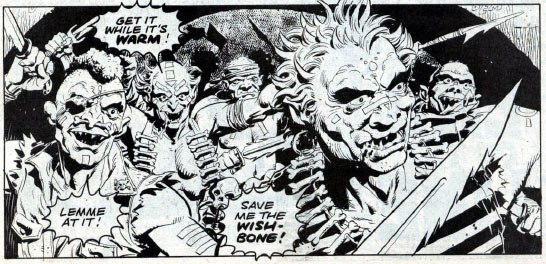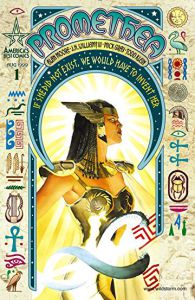First published in 2 parts in Doctor Who: A Marvel Monthly from July – August 1981. On TV, we’re still waiting for January and the start of the Fifth Doctor Era.
There are some pretty effective visuals throughout this two-parter, but nothing stood out to me as much as the sight of an elderly man’s head grafted on to the body of a small-ish dog and then being used as a tracker. It would be hard to find a more clear statement from Steve Parkhouse and Dave Gibbons that this isn’t Doctor Who as you’ve seen it before.
 But before we look at where things have diverged from what we might expect, it is worth highlighting how much of this does slot nicely into a Doctor Who formula. The Doctor arriving and finding a society in decay and despair, being preyed on by monsters, is one of the strongest tropes of the series. We’re in base-under-siege territory here – and its really the first example of that style we’ve had in the DWM run.
But before we look at where things have diverged from what we might expect, it is worth highlighting how much of this does slot nicely into a Doctor Who formula. The Doctor arriving and finding a society in decay and despair, being preyed on by monsters, is one of the strongest tropes of the series. We’re in base-under-siege territory here – and its really the first example of that style we’ve had in the DWM run.
The Doctor falling in with some local rebels is also cosy and familiar, and we even get a fairly nice “twist” that the awesome fighter who rescues him early on is actually (gasp!) a woman. She doesn’t get much of a character and is referred to as an “Angel”, but at least she’s tough and independent. There’s also some great, desperate last-minute rewiring of some sort of technical gubbins to save the day.
Which is of course where we go off the rails (I can’t promise that will be my last train metaphor, sorry). The Doctor doesn’t save the day here – the promised land of freedom and clean air that the rebels are hoping to escape to turns out to be an irradiated wilderness. The last page of the Doctor sitting outside the TARDIS waiting to see if the survivors made it is probably one of the bleakest images we’ve seen in Doctor Who at all, let alone the comic strip.
“End of the Line” has a darkness and grim intensity that the show rarely reaches for. I’m not against this in principle, and there have been any number of effective examples – I’d probably put “Inferno” up there with my top 10 stories of all time. I think what is challenging here is that despite how dark things can get in Doctor Who, we always get an example of hope or optimism at the end. We don’t get that here at all, and it’s jarring.
I don’t think it helps that there isn’t really an underlying message or idea behind any of this. It’s not even clear which planet we’re on, and it certainly isn’t explained at all how the society got to this point. It wouldn’t have made the ending any less depressing, but if we’d learnt that the citizens had brought this catastrophe upon themselves we’d at least be able to reflect on our own capacity to take actions that lead to disaster. Without that, the Doctor just meets some random people, tries to save them and completely fails.
I get the sense that this is more about style than substance anyway. This is pretty soon after Mad Max appeared, and there’s some fairly obvious influences from that film going on here. It’s also tapping in to the punk aesthetic that drove a lot of comics like 2000AD. It’s an interesting time for the comic to be wearing popular cultural influences on its sleeve, as on TV the show will spend the next five years and two Doctors desperately trying to avoid anything topical or political. Prior to this, on TV the punk influences were not really in the look of the show but in the anarchic attitude of the Doctor and, particularly during Season 17, the writers.
Here, we get something that taps right into the style and iconography of the punk movement. I don’t claim to be any kind of an expert, but having a bunch of pierced, ragged-clothing wearing types wandering around calling people “smeggs” doesn’t seem too subtle to me. Pushing them into caricature territory by having them be cannibals is exactly the kind of moves that 2000AD regularly played, and while it’s not exactly wrong for Doctor Who, it’s not a perfect fit either.
I feel like I’ve danced around this one a bit, as I can’t really land on a position. It’s quick and doesn’t overstay its welcome, Dave Gibbons does his usual amazing job, and the finale is certainly memorable. But this feels less than the sum of its parts at the end. I don’t need every story to have some incredible message and theme, but I’d like something to be underneath all the spectacle. That’s not really what we’ve got here, and it’s kind of a shame that I feel like we’re back where we were a little while ago – with a new writer learning about Doctor Who on the job, and a little way off from getting there.
Next Week: The Doctor falls in the with the Guardians of the Galaxy in “The Free-Fall Warriors”.
Advertisements Share this:




